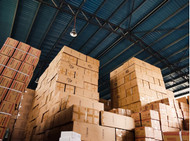21st Nov 2022
High bay lights are used to provide wide-area illumination within high bays, which typically have ceilings that are between 20 to 45 feet high. This distinguishes them from low bays, which typically have lower ceilings, between 12 to 20 feet high.
Traditionally, most high bay lights have been high-intensity discharge lamps, or HID lamps, such as metal halide (MH) lamps or high-pressure sodium (HPS) lamps. High-bay HID lights typically have very bright output, high luminous efficiency, and are powerful - 100W or more.
HID high bay lamps offer a number of advantages - but they’re also not without their drawbacks. In this article, we’re going to investigate some of the reasons that LED high bay lights are starting to take over.
The Draw of HID Lamps
For many years, HID lamps have been widely used as high-bay lighting because they produce high luminous intensity over very wide areas, which is necessary for effective high-bay illumination.
They also produce a very high-quality light and are available in numerous color temperatures ranging from cool to warm white.
HID lamps are also relatively affordable, especially when compared to some LED high bay lights, but that’s effectively where the comparative advantages stop.
Let’s take a look at the advantages of LED technology as a type of high-bay lighting.
Why People Are Migrating to LED High Bay Lights
While HID lamps have historically been a standard in high bay lighting, more and more people are choosing LED replacements. These are some of the top reasons why.
- Energy efficiency
All told, HID lamps generally offer a source efficiency of about 25%. For LED high bay lights, that number is closer to 50%.
Other estimates suggest that LEDs use anywhere from 40% to 50% less energy than equivalent HID lamps.
These are not marginal savings. They are substantial figures that can result in significant energy savings for companies that make the switch from HID lamps to LED replacements, and most importantly, some LED retrofits are plug and play compatible with existing high bay fixtures and are easy to install.

- Potentially lower cooling costs
The surface of an HID lamp can reach hundreds of degrees. LEDs, by contrast, will get warm or hot, but nowhere near as hot as HID lamps.
These hotter HID lights not only present a fire risk, when you have tens to hundreds of them burning in high bays, they have the potential to raise the internal temperature of that space by several degrees.
In the winter that’s hardly a concern, but in the summer, that can have quite an impact on cooling costs and overall energy consumption.
- Some LED lights have directional light output (unlike omni-directional HIDs)
HID lamps are generally omnidirectional, which means they throw light in all directions. This requires special reflectors or fixtures to direct the beam down.
LEDs can be manufactured to produce a directional light beam for superior light distribution, which further improves their efficiency.
- Life span
HID lights actually have really good life spans compared to most forms of lighting and will last anywhere from 8,000 to 25,000 hours.
However, this doesn’t look so impressive when compared to LED high bay lights, which on the low end will last 25,000 hours, with many lasting 50,000 or even close to 100,000.
This, in turn, results in lower maintenance and replacement costs, which drives down total cost of operating LEDs even further.
- Instant start up
HID lamps like MH lamps take from 1 to 15 minutes to reach 90% of their full brightness. It takes longer for them to warm up in the cold.
LED lamps, by contrast, reach their full brightness almost instantaneously and are minimally affected by extreme temperatures, if at all.
- Ease of disposal
It should come as a surprise to exactly no one that mercury vapor lamps contain mercury. Even fluorescent lights contain mercury and phosphor powder.
This makes it difficult to dispose of them as they contain hazardous waste. On the other hand, LEDs contain no toxic materials and in fact, some are entirely recyclable.
- Minimal/no UV emissions
HID lights have the potential to emit significant quantities of UV radiation. Admittedly, HID lamps typically trap UV emissions at their outer glass jacket - but LEDs produce almost no UV emissions, making them categorically superior.
- Equivalent range of color temperatures, light output, and excellent color rendering index
Finally, advances in technology have given LEDs every competitive advantage that HID lamps once had. Modern LEDs are available in a wide range of color temperatures and offer the same luminous efficiency and light output as even the most powerful HIDs. Moreover, they can produce excellent CRIs and render true colors.
Want to Learn More About LED High Bay Lights? Get in Touch with Us
Energy efficiency, excellent lumen output ratings, lower cooling energy costs, and high operational lifespans reaching or exceeding 50,000 hours are only some of the reasons that LED high bay lights are “outshining” HIDs.
If you want to learn more about how LED high bay lights can outperform HID lamps (and even fluorescent lights) get in touch with us at 1-800-492-9660.

